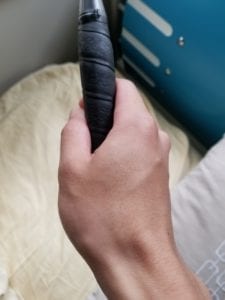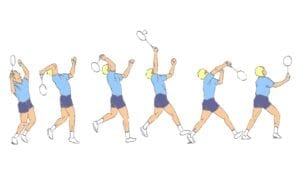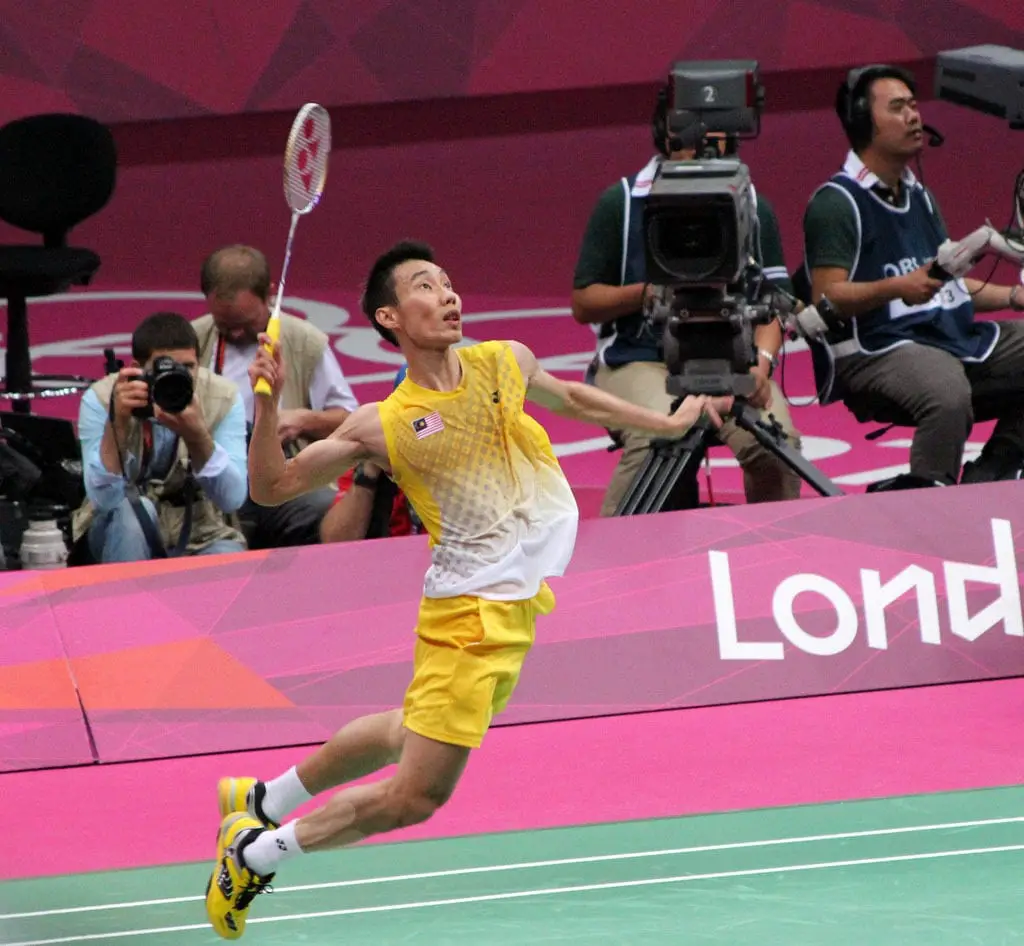Have you ever wondered how pro players manage to smash at 400km/h? It’s always extremely exciting to see a powerful and accurate smash ending the rally and game but sometimes we just can’t replicate it! To up your badminton game, I’m going to share the secrets of how to improve your badminton smash. The most important things are Technique, Contact Point, Accuracy, and Strength in that order.
Here’s how you can replicate the smashes of the pros.
Refine Your Badminton Smash Technique
If you follow pro play, you may have noticed that there aren’t any heavy lifters and body-builders playing badminton, yet pro players are still able to smash at amazing speeds. This is all due to technique.
To improve your badminton smash, you need to improve your technique. Let’s start with the grip.
Grip– The grip is one of the most important fundamentals for badminton. You can never get good with the wrong grip because your power will forever be limited. If you already have the wrong grip, do not fret. Just make sure to maintain the proper grip and only play with it. For smashes, we will be focusing on the forehand grip.



Step 1: Hold out your hand like you are going to shake hands and find the V between your thumb and index finger.
Step 2: Hold out the racket in front of you sideways.
Step 3: Put the handle into the V shape and close your grip loosely. Your thumb should be between the index finger and the middle finger and you should be holding the thin side.
To test that your grip is right, you should be able to wiggle the racket up and down effortlessly and the racket side should be facing forward.
A few common mistakes people have are having the racket face facing forwards, holding a backhand grip to swing, and having a grip in which the index finger is flat against the flat side of the grip. Beginners usually start off having the racket face facing forwards because it simply makes it easier to hit shuttles in the beginning but this is a horrible habit to maintain.
The main reason is that you will not have enough power and control to hit proper clears, drops, or smashes. This is the same reason we do not use a backhand grip to swing forehand shots. As for having your index finger straight up, this has the same reason of not enough power but it’s even worse because you can cause injury to your finger from prolonged straining. Once again if you have these problems, do not fret.
Just make sure to use the proper grip. It may feel weird the first few times and you will likely miss more shots but it will pay off. Try to check your grip after each rally to make sure it’s the proper grip.
Once you’ve got your grip, we can move onto the overhead stroke.
Overhead Stroke– Having the proper overhead swing is what’s going to generate the power in your smash so I’m going to teach you the steps for your swing.
Step 1: Stand with your right foot at the back and left foot forwards so that you are facing the side instead of the net. Put your weight towards you right foot. Hold up both arms so that your biceps are approximately 180 degrees to your shoulder. Then bend both arms up at approximately 90 degrees.  Make sure you do not rotate your grip while bringing your arms up. If you play left-handed, replace right foot with left foot and left foot with right foot.
Make sure you do not rotate your grip while bringing your arms up. If you play left-handed, replace right foot with left foot and left foot with right foot.
Step 2: Reach up with your dominant hand and turn at the same time to transfer weight towards the front. When the shuttle is extremely close to the racket, squeeze your grip and swing while moving your right leg forwards. Follow through your racket arm towards your non-dominant arm and then return to ready position. Again if you’re left-handed, change right to left and left to right.
Practice swinging by finding an open room. Just swing step by step until you get hang of it and then move onto full speed swings. Then go to a gym with some friends and practice with a shuttle.
Contact Point and Accuracy
Have you ever smashed over and over again only to have each shot returned and then proceed to lose the rally? This is because your opponents are always ready for your smashes. Where you hit the shuttle will help solve this problem.
Before we get to where to smash on the other side, I want to talk about the importance of the contact point. The basic idea is that the higher the shuttle is, the steeper you can smash. This is the reason why many people jump smash. But for purpose of this article, you want to swing when the shuttle reaches the highest point that you can hit downwards without hitting into the net. The steeper the smash, the harder it is to return.
Now let’s talk about where to aim on the court. There are three main directions to smash; cross court, down the middle, and straight. There are all sorts of situations of when to use these smashes.
Cross court smashes are usually used less because smashing cross court requires more distance to be traveled and thus the smash is also slower. You also want to be wary of the opponent’s return. This is because an opponent’s return is often a straight return so if you smash cross court, you will have to run more distance at a faster pace too.
But there are times you would use this type of smash. Lin Dan himself has his signature cross court smashes that ends many rallies. Cross court smashes work when you try to play a variety of shots. So if you have been smashing straight most of the time, the opponent might adjust more to the side you’re smashing which allows you to open up the other side. These types of smashes usually occur in singles play.
The next place you can smash is in the middle. The main places to use these smashes are during doubles games and/or against tall people. If you’re aiming for their body, you have to specifically aim it at the armpit of their racket arm. That spot is extremely awkward to block, even more if you’re tall because of longer limbs.
As for doubles games, smashing right down the middle can confuse the opponents as to who is blocking the smash. This can lead to points from opponent’s miscommunication. We don’t use this smash too much in singles because players generally go back to middle so they’re already ready for these types of shots.
Finally, we have straight smashes. These are your common go to smashes. Usually you want to smash straight because traveling less distance means it will go faster and you can pressure on their block easier as most people block straight. However, this means players will start positioning themselves closer to where a straight smash would be so use the other smashes occasionally to diversify your offense.
So now that you’ve learned the right technique and where to smash, it’s time to put it into practice.
Drills For Smashing
Drill 1: This is the most basic drill for practicing straight smashes. I am going to explain two variants. For the simplicity of explaining, I am going to set two people as A and B. A is going to serve high to B on a half court, B is then going to smash, A then blocks, B lifts and repeat.
The other variant is A lifts, then B smashes, A blocks, B net shots, A lifts and repeat. Then swap.
This drill is great for practicing straight smashes and body smashes and it takes the least amount of skill but it lacks a lot for increasing strength and where you smash because you want to make sure you can keep the rally going. With this one just try to see if you can keep the rally going.
Drill 2: Drill 2 is having someone feed you lifts and then you smash. This is great because you can practice straight smashes and cross court ones and go full power as well. The downside of this one is it’s hard to find someone who can feed you really well. Try 3 sets of 16 for this drill.
Drill 3: This drill is 2 on 1. There are also two variants to this drill; one where the doubles stand side by side and one where the doubles stand front and back, defense and offense respectively. This drill is really great to practice defense or offense overall, you just need 3 people though.
Let’s start with side by side. With this drill the doubles pair is defending and the only shots they can play are clears, lifts, and blocks. The singles player is playing full offense so it’s a great time to practice smashes.
When you swap to front and back, the front player can only play net shots or lifts and the back player can play drops, clears, and smashes. The singles player in this case can only block, clear, and lift. With these drills make sure to rotate every 3 to 5 minutes so everyone gets a chance to practice. This drill doesn’t necessarily focus on smashing but it’s great for defense and offense so inevitably you get chances to smash.
Exercises To Improve Strength
I said that body-builders are not necessarily the strongest smashers but you still need to build strength as well; just make sure you have mastered the technique. Badminton is an intense sport and believe it or not, smashing requires use of your whole body.
Your forearm rotation and grip squeeze for when you hit the shuttle, your upper body rotation, your lower body steps; these all require strength so here are some exercises you can do.
Push Ups- These are all-around good for your upper body so it’s a basic core to badminton exercises. Do how much you can do but make sure you do them properly. Keep your back straight and have your arms bend to 90 degrees and then go back up. My recommendation is around 3 sets of 10 but increase it or decrease depending on your strength.
Plank- Your core is really important in badminton. One of my favorite core exercises is planking. When planking, it is extremely important to keep your back straight so you get the full work out. My recommendation is 3 sets of 1 minute.
Squats- Legs are very important in badminton, not just smashes. They are how you’re going to get around on the court. Squatting is one of the many exercises good in badminton. When you squat, make sure you bend your knees down to at least 90 degrees. My recommendation is 3 sets of 10.
Pull Ups- Finally pull-ups. These are pretty difficult but worth it. When doing pull ups, make sure you go all the way down and then back up. My recommendation is 3 sets of 5.
Your routine should look something similar to this.
- 3 sets of 10 push-ups
- 3 sets of 1 minute planks
- 3 sets of 10 squats
- 3 sets of 5 pull ups
Among these exercises there are many more but these are some basic ones to get you started.
Smash a Hole!
What this long article tells you is that the most important things to your smash are technique, contact point, accuracy, and strength. I hope you’ve got some ideas for how to improve your badminton smash!
Another thing you need is consistent practice so make sure you go out and practice your smash as much as you can so you can show off that fearful smash to friends and opponents!
If you have any questions or comments, please leave them below and I wish for your best in your games.


hey.
Hi.
hey
What’s up?